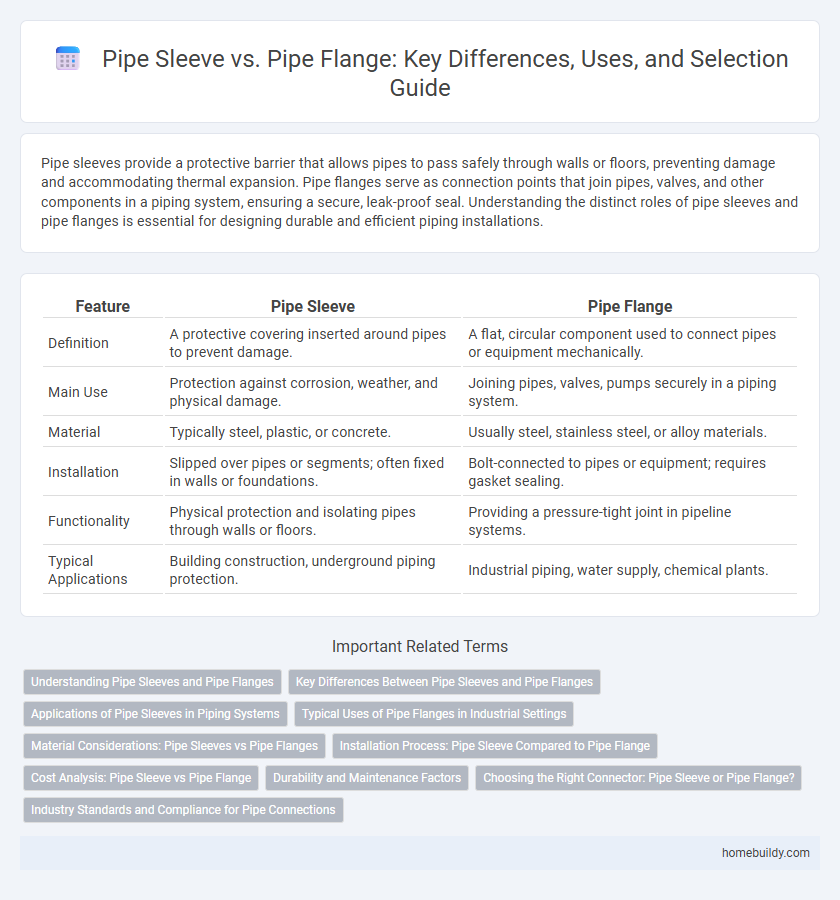Pipe sleeves provide a protective barrier that allows pipes to pass safely through walls or floors, preventing damage and accommodating thermal expansion. Pipe flanges serve as connection points that join pipes, valves, and other components in a piping system, ensuring a secure, leak-proof seal. Understanding the distinct roles of pipe sleeves and pipe flanges is essential for designing durable and efficient piping installations.
Table of Comparison
| Feature | Pipe Sleeve | Pipe Flange |
|---|---|---|
| Definition | A protective covering inserted around pipes to prevent damage. | A flat, circular component used to connect pipes or equipment mechanically. |
| Main Use | Protection against corrosion, weather, and physical damage. | Joining pipes, valves, pumps securely in a piping system. |
| Material | Typically steel, plastic, or concrete. | Usually steel, stainless steel, or alloy materials. |
| Installation | Slipped over pipes or segments; often fixed in walls or foundations. | Bolt-connected to pipes or equipment; requires gasket sealing. |
| Functionality | Physical protection and isolating pipes through walls or floors. | Providing a pressure-tight joint in pipeline systems. |
| Typical Applications | Building construction, underground piping protection. | Industrial piping, water supply, chemical plants. |
Understanding Pipe Sleeves and Pipe Flanges
Pipe sleeves provide a protective barrier that allows pipes to pass through walls or floors without damage, ensuring structural integrity and facilitating thermal expansion. Pipe flanges are mechanical connectors used to join pipes, valves, or equipment, offering easy assembly and disassembly for maintenance. Understanding the distinct roles of pipe sleeves in protection and pipe flanges in connection is essential for efficient piping system design.
Key Differences Between Pipe Sleeves and Pipe Flanges
Pipe sleeves provide protection and insulation by encasing pipes as they pass through walls or floors, preventing damage and allowing for thermal expansion. In contrast, pipe flanges serve as connectors between pipe sections, enabling easy assembly, disassembly, and maintenance by providing a secure, leak-proof joint. Key differences include their primary functions--pipe sleeves are protective barriers, whereas pipe flanges are mechanical joining components--and their installation locations, with sleeves embedded in structures and flanges located at pipe ends.
Applications of Pipe Sleeves in Piping Systems
Pipe sleeves are primarily used for protecting pipes from corrosion, mechanical damage, and thermal expansion within walls and floors, ensuring durability in building construction and industrial piping systems. Unlike pipe flanges, which serve as connection points for joining pipes, pipe sleeves provide a sealed passage that maintains the integrity of the structure while allowing pipe movement. Applications of pipe sleeves include facilitating pipe installation, preventing damage from external forces, and enabling easy maintenance in HVAC systems, water supply networks, and chemical processing plants.
Typical Uses of Pipe Flanges in Industrial Settings
Pipe flanges are commonly used in industrial settings to connect pipes, valves, pumps, and other equipment, providing easy access for inspection, cleaning, and maintenance. They are ideal for high-pressure and high-temperature applications, ensuring a secure and leak-proof joint. Typical uses include oil and gas pipelines, chemical processing plants, and power generation facilities where robust and reliable connections are essential.
Material Considerations: Pipe Sleeves vs Pipe Flanges
Pipe sleeves are typically made from materials like steel, PVC, or concrete to provide insulation and protect pipes from external damage, while pipe flanges often use forged carbon steel, stainless steel, or alloy steels to ensure a secure, leak-proof connection in high-pressure systems. The material selection for pipe sleeves emphasizes durability and corrosion resistance in encasement applications, whereas pipe flanges require materials that can withstand mechanical stress and thermal expansion during operation. Understanding these material differences is critical to optimizing pipe system integrity, longevity, and performance under varying environmental and operational conditions.
Installation Process: Pipe Sleeve Compared to Pipe Flange
Pipe sleeves offer a simpler installation process compared to pipe flanges, requiring minimal alignment and fewer components. Unlike pipe flanges that need precise bolt tightening and gasket placement, pipe sleeves can be easily inserted into walls or floors, facilitating faster sealing and protection of pipes. This efficiency reduces labor time and potential errors during the installation phase.
Cost Analysis: Pipe Sleeve vs Pipe Flange
Pipe sleeves generally offer a more cost-effective solution compared to pipe flanges due to lower initial material and installation expenses. While pipe flanges enable easier disassembly and maintenance, their higher manufacturing and bolting costs can increase the overall project budget. Evaluating long-term maintenance and operational requirements is essential for a precise cost-benefit analysis between pipe sleeves and pipe flanges.
Durability and Maintenance Factors
Pipe sleeves offer superior durability by providing consistent protection against corrosion and environmental damage, reducing the need for frequent maintenance compared to pipe flanges. Unlike pipe flanges, which can experience wear at bolt joints and require regular inspection and tightening, pipe sleeves maintain structural integrity with minimal intervention. Maintenance for pipe sleeves is generally simpler and less costly, making them ideal for long-term applications in harsh conditions.
Choosing the Right Connector: Pipe Sleeve or Pipe Flange?
Selecting the right connector between a pipe sleeve and a pipe flange depends on the application requirements and installation ease. Pipe sleeves provide a protective barrier for pipes passing through walls or floors, ensuring structural integrity and corrosion resistance without requiring dismantling of the pipe system. In contrast, pipe flanges offer secure, detachable joints ideal for maintenance and inspection, often used in high-pressure or high-temperature systems where frequent assembly and disassembly are necessary.
Industry Standards and Compliance for Pipe Connections
Pipe sleeves and pipe flanges serve distinct roles in pipe connections, with pipe sleeves primarily used for protection and insulation, while pipe flanges provide a secure, leak-proof joint between pipes. Industry standards such as ASME B16.5 and ASTM F477 govern pipe flange and sleeve manufacturing to ensure durability, pressure resistance, and corrosion protection. Compliance with these standards is critical for meeting safety and operational requirements in sectors like oil and gas, petrochemical, and construction.
Pipe sleeve vs Pipe flange Infographic

 homebuildy.com
homebuildy.com